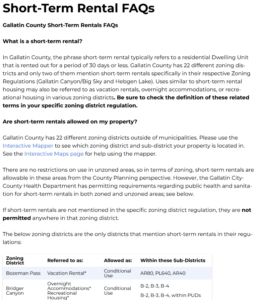Update: the survey results are currently on hold, pending development of a valid way to remove some duplicate entries. A couple of people availed themselves of the untracked form to submit many responses, making the results invalid as a measure of general canyon sentiment. About all we can say at the moment is that on the first couple days, when responses were heavy, outweighing repeat submissions, the results looked a lot like they did in 2016, with perhaps a small shift toward a more favorable view of STRs.
Regardless of the outcome of the Jan. 11 hearing, we think it would be better for the zoning regulation to be explicit about STRs, so that permissible uses and distinctions from related classifications like Guest Ranches and Overnight Accommodations are clear. Therefore we’re interested in your opinion, not only for the pending matter, but also a future zoning amendment. Please give us your feedback in the following survey:
https://forms.gle/BK4xySf7iAWQh6sC6
The form has three fairly brief parts. Page 1 repeats some questions that we asked in 2016, when the zoning advisory committee originally drafted an STR standard. Page 2 considers some additional questions related to the recent and pending hearings. Page 3 seeks feedback on the current draft, which is now 5 years old.
Please take a look soon, because we’re just a week out from the hearing.
Background
History
Several classifications that provide for accommodations have been present in the zoning for a long time. In the Bridger Bowl Base Area, the B-districts provide for Overnight Accommodations and Recreational Housing. In the AE district (most of the Canyon), those aren’t available, but there are Guest Ranch and Bed and Breakfast classifications. All of these are conditional uses. Nothing in the regulations mentions short-term rentals by name.
In 2016-2017, the Zoning Advisory Committee (BCZAC) held a series of public meetings to discuss STRs, including a well-attended one at the fire station community room. We also ran a survey via the BCPOA email list. Following those sessions, BCZAC drafted a standard that created a Conditional Use Permit for short term rentals.
In 2021, the Planning Department submitted a zoning amendment incorporating the BCZAC work, but omitting the STR and PUD sections. BCPOA opposed these omissions, but supported the amendment as a whole, for many other beneficial improvements to the zoning language.
Current Status of STRs
The county’s current interpretation of zoning regulations is that STRs are not permitted in most zoning districts:
If short-term rentals are not mentioned in the specific zoning district regulation, they are not permitted anywhere in that zoning district.
The only exception in Bridger Canyon is Overnight Accommodations and Recreational Housing in the Base Area. See the STR FAQ for details. BCPOA had nothing to do with the drafting of this interpretation, and in fact just discovered the county’s web page yesterday.
BCPOA Position
BCPOA doesn’t have a formal position statement on STRs, and there’s some diversity of board member views. We have certainly never tried to ban them – in fact, we spent a lot of time and money trying to induce the county to adopt a CUP legalizing them.
Generally we think a ban would be difficult to enforce and possibly counterproductive, so it would be better to permit STRs with a few safeguards against nuisances and density creep. No matter what the standards are, we would like to see the adoption of explicit language mentioning STRs, to avoid the ambiguity that has led to the current appeal.
BCPOA’s Role
BCPOA isn’t a regulator; we’re an advocate for Bridger Canyon. From our bylaws:
The purpose of this corporation shall be:
- to preserve the rural character and the natural beauty and resources of Bridger
Canyon;- to guide and direct orderly growth and development;
- to maintain, through organization, a definite influence in all matters which may
affect residence or property rights and enjoyment thereof;- to disseminate information regarding zoning requirements and local issues, and
- to hold regular meetings for open discussions of problems of mutual interest and
concern
The zoning regulations are administered by the Planning Department. Conditional Uses, appeals, variances and amendments are elevated to the Planning & Zoning Commission or the County Commission.





 Twitter
Twitter Facebook
Facebook RSS
RSS Email
Email